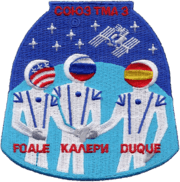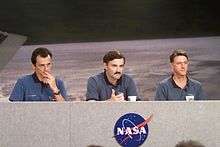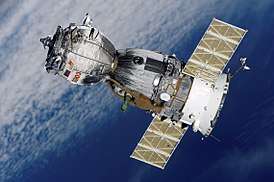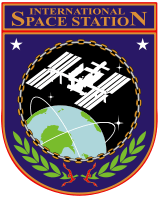Soyuz TMA-3
Soyuz TMA-3 was a Soyuz (Russian Союз ТМА-3, Union TMA-3) mission to the International Space Station (ISS) launched by a Soyuz FG launch vehicle which was the third flight for the TMA modification of the Soyuz spacecraft, and the 7th Soyuz to fly to the ISS.
| Operator | Rosaviakosmos |
|---|---|
| COSPAR ID | 2003-047A |
| SATCAT no. | 28052 |
| Mission duration | 194 days, 18 hours, 33 minutes, 12 seconds |
| Orbits completed | ~3,170 |
| Spacecraft properties | |
| Spacecraft type | Soyuz-TMA 11F732 |
| Manufacturer | RKK Energia |
| Crew | |
| Crew size | 3 |
| Members | Aleksandr Kaleri Michael Foale |
| Launching | Pedro Duque |
| Landing | André Kuipers |
| Callsign | Ingul |
| Start of mission | |
| Launch date | October 18, 2003, 05:38:03 UTC |
| Rocket | Soyuz-FG |
| Launch site | Baikonur 1/5 |
| End of mission | |
| Landing date | April 30, 2004, 00:11:15 UTC |
| Landing site | 50.38° N, 67.20° E |
| Orbital parameters | |
| Reference system | Geocentric |
| Regime | Low Earth |
| Perigee altitude | 193 kilometres (120 mi) |
| Apogee altitude | 227 kilometres (141 mi) |
| Inclination | 51.67 degrees |
| Docking with ISS | |
| Docking port | Pirs nadir |
| Docking date | 20 October 2003 07:16 UTC |
| Undocking date | 29 April 2004 20:52 UTC |
| Time docked | 192d 13h 36m |
  Soyuz programme (Crewed missions) | |
Crew
| Position | Launching crew | Landing crew |
|---|---|---|
| Commander | Expedition 8 Fourth spaceflight | |
| Flight Engineer | Expedition 8 Sixth and last spaceflight | |
| Flight Engineer | Second and last spaceflight |
First spaceflight |
Original Crew
| Position | Crew | |
|---|---|---|
| Commander | N/A (Taxi Flight) Third spaceflight | |
| Flight Engineer | N/A (Taxi Flight) First spaceflight | |
| Flight Engineer | N/A (Taxi Flight) First spaceflight | |
Mission parameters
- Mass: ? kg
- Perigee: 193 km
- Apogee: 227 km
- Inclination: 51.7°
- Period: 88.6 min
Docking with ISS
Specifications
- Max. altitude - 387.1 km
- Min. altitude - 357.9 km
- Period - 91.7 min
- Inclination - 65.64°[3]
Mission highlights

The commander of the Soyuz was Aleksandr Kaleri (RKA). The flight engineer was Michael Foale (NASA), and Pedro Duque (ESA) served as the second flight engineer. After docking with the ISS they exchanged the current crew on ISS and became the eighth station crew, called "ISS Expedition Eight". During the stay on the station Michael Foale was the ISS Commander, while Aleksandr Kaleri was the engineer. Foale was the first American to have served on both Mir and the ISS. Pedro Duque performed some ESA sponsored science experiments under the mission name Cervantes and then returned with the ISS 7 crew on Soyuz TMA-2.
The backup crew was William McArthur, Valery Tokarev and André Kuipers.
Foale and Kaleri along with André Kuipers, the third seater from TMA-4 landed on April 29, 2004, near Arkalyk, Kazakhstan. A minor helium leak did not affect their mission.
References
- "OFFICIAL PRESS RELEASE about the landing of Soyuz TMA-3 descent vehicle". NPO Energia. April 30, 2004. Retrieved December 17, 2008.
- "Return to space for Spanish ESA astronaut". ESA. October 16, 2003. Retrieved December 17, 2008.
- Energia.RU Press Release ISS

